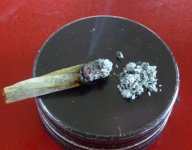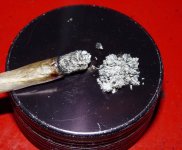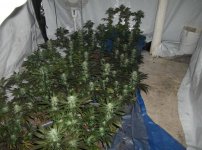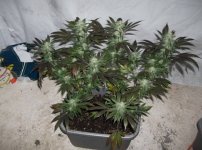I usually cut feeding and eventually stop all together because I was under the impression that the plant would do it anyway. It was more to not waste nutrients than "flush" anything.
But, I am a sucker for science.
And the science is on homebrewers side. Its pretty clear.
The notion that you are "flushing chlorophyl" from leaves is ridiculous. Chlorophyl is essential for plants. It is a major component of photosynthesis.
If water "flushed" anything from the plant, it would be detrimental. Water and plants are friends.
What you are doing by flushing is creating a nutrient deficiency. The discoloration is the symptom(s) of the newly deficient nutrient.
In the case of a deficiency, the buds will pull the needed nutrients from the stores (the leaves) into themselves (sinks). So the fan leaves yellow and fall off because the flowers have sucked out all their chlorophyl.
And the white ash test is bogus. It doesn't say anything about the "cleanliness" of the bud, just the nutrients in the medium. Flushing would then seem to be a poor way to achieve a white ash.
If the plants were naturally turning colors and losing leaves, then flushing would be unnecessary. Why would you need to deprive the plant to induce a naturally occurring phenomenon?
I have 6 plants close to harvest and the healthiest looking, green plant looks the best. As much as I love the purples, oranges, blues and reds I can get in late flowering, it really doesn't make sense.
But, I am a sucker for science.
And the science is on homebrewers side. Its pretty clear.
The notion that you are "flushing chlorophyl" from leaves is ridiculous. Chlorophyl is essential for plants. It is a major component of photosynthesis.
If water "flushed" anything from the plant, it would be detrimental. Water and plants are friends.
What you are doing by flushing is creating a nutrient deficiency. The discoloration is the symptom(s) of the newly deficient nutrient.
In the case of a deficiency, the buds will pull the needed nutrients from the stores (the leaves) into themselves (sinks). So the fan leaves yellow and fall off because the flowers have sucked out all their chlorophyl.
And the white ash test is bogus. It doesn't say anything about the "cleanliness" of the bud, just the nutrients in the medium. Flushing would then seem to be a poor way to achieve a white ash.
If the plants were naturally turning colors and losing leaves, then flushing would be unnecessary. Why would you need to deprive the plant to induce a naturally occurring phenomenon?
I have 6 plants close to harvest and the healthiest looking, green plant looks the best. As much as I love the purples, oranges, blues and reds I can get in late flowering, it really doesn't make sense.








